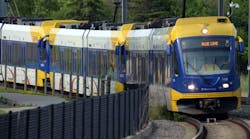Surface transportation legislation movement in House and Senate
It’s been a busy week for surface transportation legislation on Capitol Hill as the House Committee on Transportation and Infrastructure (T&I) approved the $547-billion INVEST in America Act out of committee following a 19-hour markup of both the surface transportation legislation, as well as the Water Quality Protection and Job Creation Act of 2021.
The legislation includes $109 billion for transit, $95 billion for passenger and freight rail and $343 billion for roads, bridges and safety over a five-year timeframe. The bill also includes $5.6 billion in Member Designated Projects, informally referred to as earmarks, with more than $1 billion of these projects benefiting 237 transit projects in the U.S.
“Infrastructure is calling, and we are answering with bold legislation that invests in American workers and communities and lays the groundwork for the president’s visionary Americans Jobs Plan,” said Chair Peter DeFazio (D-OR-04). “I commend my colleagues for their hard work helping craft these two bills to deliver what Americans expect and deserve: safe roads and bridges, reliable transit options and a robust passenger rail network, wastewater systems that aren’t on the brink of failure, and a commitment to address the existential threat of climate change. In many ways, the choice couldn’t be easier—because the best part of rebuilding our infrastructure for the modern era is the incredible opportunity for our nation that comes with it. We’re talking millions of good-paying jobs that can’t be exported, real and sustained support for U.S. manufacturing, and the chance to make our nation a world leader once again. This is a once-in-a-generation opportunity that we can’t afford to miss.”
However, the committee’s Ranking Member Sam Graves (R-MO-06) critiqued the process as being partisan, citing several amendments put forth by Republican committee members that were not agreed to during the markup.
“Instead of working with Committee Republicans this year to find a compromise that addresses priorities for members on both sides of the aisle, the majority elected to move further away from any middle ground,” the minority included in a recap of the markup.
The bill now moves to the full House for consideration.
On the other side of the Hill, the U.S. Senate Committee on Commerce, Science and Transportation introduced the Surface Transportation Investment Act. The proposal authorizes $78 billion in rail, multimodal and safety programs over the five-year life of the bill. The legislation includes $36 billion for rail, $27.8 billion for multimodal grant programs and $13 billion for safety programs.
The proposal includes $1.5 billion annually for the U.S. Department of Transportation’s Rebuilding American Infrastructure with Sustainability and Equity (RAISE) grants (formerly known as BUILD and TIGER grants) and $2 billion annually to fund big dollar value projects of national significance.
Within the funding for rail, the legislation would authorize more than $25 billion over five years for intercity passenger rail and $7.5 billion for rail safety and improvement projects. The bill includes a new $500-million-per-year grant program to eliminate grade crossings and makes improvements to the Railroad Rehabilitation and Improvement Financing Program.
In late breaking news during the evening of June 10, a group of 10 U.S. Senators shared they had reached a compromise on an infrastructure deal.
The joint statement said, “Our group – comprised of 10 Senators, five from each party – has worked in good faith and reached a bipartisan agreement on a realistic, compromise framework to modernize our nation’s infrastructure and energy technologies. This investment would be fully paid for and not include tax increases. We are discussing our approach with our respective colleagues, and the White House, and remain optimistic that this can lay the groundwork to garner broad support from both parties and meet America’s infrastructure needs.”

Mischa Wanek-Libman | Group Editorial Director
Mischa Wanek-Libman is director of communications with Transdev North America. She has more than 20 years of experience working in the transportation industry covering construction projects, engineering challenges, transit and rail operations and best practices.
Wanek-Libman has held top editorial positions at freight rail and public transportation business-to-business publications including as editor-in-chief and editorial director of Mass Transit from 2018-2024. She has been recognized for editorial excellence through her individual work, as well as for collaborative content.
She is an active member of the American Public Transportation Association's Marketing and Communications Committee and served 14 years as a Board Observer on the National Railroad Construction and Maintenance Association (NRC) Board of Directors.
She is a graduate of Drake University in Des Moines, Iowa, where she earned a Bachelor of Arts degree in Journalism and Mass Communication.




